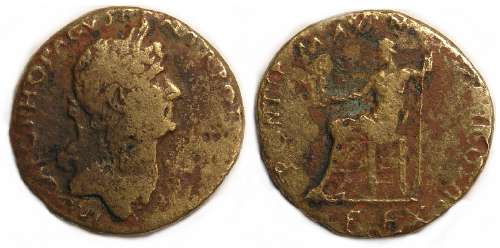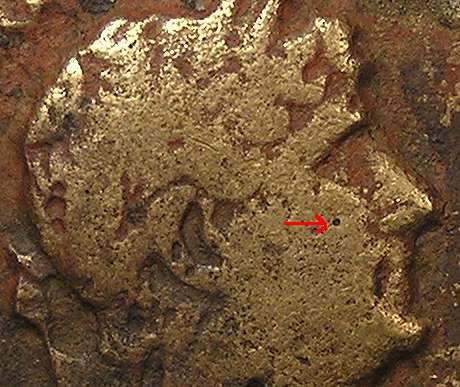
Fake Otho / Hadrian Sestertius
Enlargement This is one of the more interesting forgeries I have seen recently. Unfortunately it is not in my own collection, lent to me by Jim Hauck so that I would study and photograph it. It is presented here with Jim's permission. At first glance it appears to be a fairly ordinary Hadrian sestertius in rather corroded condition, similar to coins found in water with what is commonly known as a Tiber patina. On closer examination one notices the obverse inscription names OTHO, and one can (and others have) conclude it is a genuine Hadrian sestertius tooled to pass as an Otho (who is not known to have issued Imperial bronze coins). After careful examination, I now believe it is an outright modern cast fake, most likely to have been made in the 17th or 18th century. MANUFACTURE: Cast forgery, probably by the lost wax method. SIZE: 30.2 x 32.1 mm. THICKNESS: 2.6 TO 3.0 mm at the rim, 3.6 at the portrait. WEIGHT: 18.32 grams. FIRST IMPRESSION:Ancient but tooled in modern times. RELATIVE DANGEREXPERIENCED DEALER - low as a Otho, high as a tooled Hadrian. COLLECTOR WITH EXPERIENCE - low as a Otho, high as a tooled Hadrian. COLLECTOR BUT NOVICE - low as a Otho, high as a tooled Hadrian. Anyone familiar with Otho's portrait will know this is not Otho, but I know of two people that examined this coin and concluded it was a genuine Hadrian with Otho's name tooled onto it. In that respect it is a very dangerous fake. CHARACTERISTICS: On first examination the rough surfaces appeare consistent with a heavily corroded genuine coin, with lots of genuine encrustations, and on which the inscription has been tooled place Otho's name on it. What at first bothered me was I could see no evidence of tool marks around the altered letters. I wondered if it had been acid etched after the tooling, thus removing such marks, but when I examined the edges I saw this : 
These file marks are at about 3 o'clock relative to the obverse, inconsistent with a jewellery mount removal, so in my opinion these are most like marks from a casting sprew removal, indicating this coin is most likely a casting that has been artifically patinated. There is what looks like corrosion above, below, and to either side of the file marks, but none on the file marks. This eliminates the possiblity of a genuine coin filed to test the metal when it was found, then tooled and acid treated later. The only conclusion I can come to is it was cast to look rough. 
I also noted the one very small almost perfectly round depresson on the cheek (marked with the arrow) which appears to be the result an air bubble caught in the molding process, and consistent with a lost-wax casting. The lack of tooling marks in the modified areas are consistent with "tooling" in the form of modification to the wax prior to casting. If you look closely you will find many details on both sides of the coin that have been modified, including the truncation of the bust, the "S C" that should be below Jupiter is now an "F P X (which makes not sense at all) and other small details all over the coin. Here is the process by which I believe this fake was made Three is no way to date this fake accurately, but I doubt it was made later than the early 19th century, and it could be 18th or even 17th century work. I assume this as it has be have been made prior to good images (either photogrpahs or engravings) of ancient coins being readily available for it to have any chance of being sold as a genuine Otho sestertius. It probably would have been prior to easy access to the information that Otho did not strike Imperial bronzes, which was in many books by the mid 18th century. I also see no reason a much more modern forger would want to use a method this complicated to make such a forgery. Back to examples of fakes. Top of Page
|

